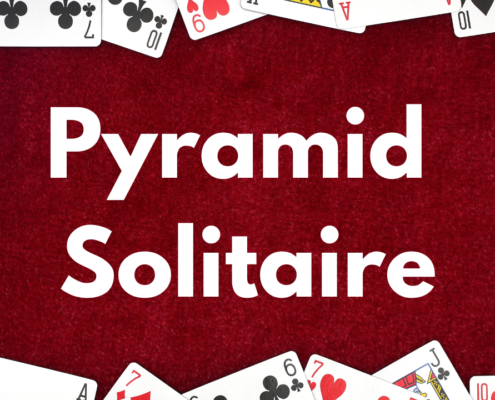How to Play Pyramid Solitaire | Guide to Rules, Instructions & More
What is Pyramid Solitaire
Pyramid Solitaire is a fun version of the game where the tableau is stacked in a 6 row pyramid instead of in individual stacks. Players may only play cards that aren’t covered by other cards and attempt to find and remove matching pairs that sum to thirteen. Pyramid Solitaire is a game that involves both luck and skill. In the most common version, called “Relaxed Pyramid Solitaire,” which is outlined in this article, a player wins when they have removed all the cards in the pyramid.
Objectives
Remove all the cards from the pyramid by forming pairs of cards that sum to thirteen.
Number of players
1. It’s called solitaire, right? :)
Age
6 and up for the standard pyramid solitaire that adds to 13.
5 and up for “Pair 10” pyramid solitaire in the variation section below.
What you need / equipment
Standard 52-card playing deck
Skills
- Strategy: Players need to look at the pyramid and make decisions based on the placement of cards and what will open up different sections of the board.
- Math: Players use addition skills to find matching pairs of cards that sum to thirteen.
Why we like Pyramid Solitaire for kids and families
It’s great to have a single-player card game that your child can play instead of getting on a device! Plus, they’re using math skills as they attempt to find pairs of cards that sum to thirteen.
How to Play Pyramid Solitaire with a deck of cards
The same method applies to online play, but here we’ll describe the set up and mechanics if you have a physical deck of cards.
1: Grab a deck of cards and find a flat playing surface
All you need to play Pyramid Solitaire is a standard deck of playing cards and a flat surface to play on.
2: Set up the game by shuffling the deck and building 7 rows, 28 card pyramid
Shuffle a 52-card deck of playing cards, then deal out 28 cards into 7 rows to form a pyramid. The first row will have 1 card and each subsequent row will have one additional card in it. When placing the new row on top of it, the cards should be slightly overlapping. For example, in row two, one of the cards will cover the bottom left of the single card in the previous row and one of the cards will cover the bottom-right of the single card above it.
The card distribution will be as follows:
- Row 1: 1 Card
- Row 2: 2 Cards
- Row 3: 3 Cards
- Row 4: 4 Cards
- Row 5: 5 Cards
- Row 6: 6 Cards
- Row 7: 7 Cards
- Total = 28 cards
The remaining card should be in a single stack, face down, to form the stockpile.
3: Look for matches and clear them
You remove cards from the pyramid when you find a pair the sums to thirteen. But only “free” cards (ones that aren’t covered by a card in a lower row) can be played from the pyramid.
Card value are as follows:
- Aces = 1
- 2-10 = Face value
- Jack = 11
- Queen = 12
- King = 13
When looking at the board, you can immediately remove any Kings as they are worth 13 points and don’t have to be paired with another card.
You will also look for matching pairs of 13 on the “free” pyramid cards.
Additionally, you can flip the top card over from the stockpile and play that card. If you don’t play it, you move it face up into the “waste pile” and flip over the next top card in the stockpile. You will often have a face up card in both the stockpile and the waste pile that are open for being played.
Pairs that sum to 13 can be from any combination of two cards from the “free” cards in the pyramid, the top stockpile card, or the top waste pile card.
As you pair up cards that sum to 13, you’ll remove them both and place them in a separate “discard pile.”
4: Continue playing until you clear the pyramid or no moves are left left
If you cycle all the way through the stockpile, you can flip over the waste pile and, without shuffling, flip it over to form a new stockpile.
The game is over when either:
- You clear all the cards from the pyramid and you win!
- You have no moves left and haven’t cleared the entire pyramid, in which case you lose
Pyramid Solitaire Rules
- The game is won once the pyramid cards are all cleared. That means you still win if there are cards left in the stockpile or waste pile (except in the “clear all” variation described below)
- You lose the game when there are no moves left and there are still cards in the pyramid.
- The only cards that can be played to form pairs that sum to 13 are:
- “Free” (i.e. fully uncovered) cards in the pyramid
- top stockpile card
- top waste pile card
- Any card in the pyramid still covered by either 1 or 2 cards, may not be played. Any card in the stockpile or waste pile that is not the top card may not be played. Any card in the discard pile may not be played.
- Any two free pyramid card pairs of 13 can be played and moved to the discard pile.
- The top stockpile card and any free pyramid card that pairs to 13 can be played and moved to the discard pile.
- The top waste pile card and any free pyramid card that pairs to 13 can be played and moved to the discard pile.
- The top stockpile card and top waste pile card can be paired and moved to the discard pile if the total is 13.
- You can skip moves strategically; you don’t have to play an available move.
- Once stockpile runs out, you can flip over the waste pile, unshuffled, to form a new stockpile.
Pyramid Solitaire Variations
Clear ALL cards, not just the pyramid
The popular version outlined above is known as “Relaxed Pyramid Solitaire,” where only the pyramid needs to be cleared (i.e. you still win if there are cards left in the stockpile and/or waste pile). If you want to make the game more challenging, you can play where ALL cards have to be cleared, including the pyramid, stockpile, and waste pile. But the odds of a game being solvable drop to 2% when playing this stricter version. In our opinion, that’s just not enough winning to be fun! We suggest playing relaxed pyramid solitaire, then celebrate a little extra if you’re also able to clear the remaining cards from the stockpile and waste piles.
Pair 10 math version
One of the variations we love for kindergarten and 1st graders is to remove the face cards and pair 10s instead of 13s. This game really helps kids meet the common core standards of being able to pair any number with its counterpart that sums to 10!
Pyramid Solitaire Strategy
Pyramid Solitaire involves both luck and skill. But here are X strategies to help you win more!
- Clear kings and don’t think more about them: There is no strategic difference to how you play kings, so just move them to the foundation/discard pile as soon as you see them.
- Look ahead at your board: You should look at how covered cards might match as you play your cards. This will help you decide which area of the board is better to attack first.
- Don’t jump at the first match you see. If you’d followed the advice above and looked ahead at your board, you’ll have a better idea of what area of the board you want to attack. So dont’ just go after the first possible match.
- Don’t play a stock/waste combo right away: There’s no advantage to playing a stock/waste pair of 13 early. In fact, since you don’t shuffle the waste/stock, those same cards can be matched later if they end up not being useful for clearing the pyramid. You’re better off seeing if it can help clear your pyramid.
Glossary
Tableau / Pyramid: The tableau in Pyramid Solitaire are the cards that form the pyramid. The term pyramid and tableau are used interchangeably.
Stockpile: The stockpile is the stack left over after the 28 card pyramid is formed. The stockpile cards should be in a single stack, but the top card of the stockpile is flipped over and playable. If not played, it is moved to the waste pile.
Waste Pile: The waste pile is formed from stockpile cards that are not used. The top card in the waste pile is playable.
Foundation / Discard Pile: The foundation in Pyramid Solitaire is where all cleared cards that pair to 13 are placed. It is also often called the discard pile in this version of solitaire. The foundation should be in a single pile, face down, to the side of the pyramid.



